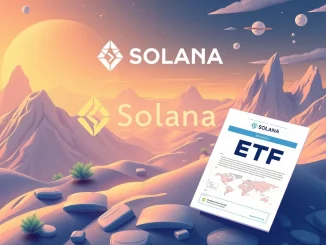
Could a memecoin ETF be coming sooner than you think? The world of cryptocurrency investing is constantly evolving, and a recent prediction from a respected voice suggests even the most volatile assets could find a place in traditional investment vehicles.
What Did the Bloomberg Analyst Predict?
According to a post on X (formerly Twitter) on June 7, Bloomberg analyst Eric Balchunas shared his insights into the future of crypto-focused exchange-traded funds (ETFs). Balchunas, known for his analysis of the ETF market, believes there’s a significant possibility that an actively managed ETF specifically focused on memecoins will eventually launch.
His prediction outlines a potential timeline:
- Several actively managed crypto ETFs could roll out by winter 2025.
- A fund dedicated exclusively to memecoins might follow sometime in 2026.
This forecast highlights the growing interest in bringing various forms of crypto exposure to traditional markets via the ETF structure.
Why Active Management Suits Memecoins
Balchunas explained his reasoning for why memecoins are a good fit for active management rather than a passive index fund. He pointed to two primary factors:
- High Return Volatility: Memecoins are notorious for their extreme price swings. An actively managed fund allows managers to potentially navigate this volatility, making timely decisions to buy or sell based on market conditions, news, and sentiment, rather than simply tracking an index that includes all memecoins.
- Limited Analyst Coverage: Compared to major cryptocurrencies like Bitcoin or Ethereum, memecoins receive relatively little coverage from traditional financial analysts. This lack of widespread research creates opportunities for active managers to potentially identify undervalued or emerging memecoins before they gain broader attention.
An actively managed crypto ETF focusing on memecoins would allow professional managers to attempt to capitalize on the unique dynamics of this market segment.
What Does This Mean for a Memecoin ETF?
The prospect of a memecoin ETF launching, as predicted by Eric Balchunas, has several implications:
- Accessibility: It could provide traditional investors with easier access to the memecoin market without the complexities of setting up crypto wallets or using specific exchanges.
- Legitimacy: The existence of an ETF, particularly one from a reputable issuer, could lend a degree of legitimacy to the memecoin category in the eyes of some mainstream investors, despite their speculative nature.
- Regulatory Hurdles: Such a product would face significant scrutiny from regulators, given the inherent risks and volatility of memecoins. Approval is far from guaranteed and would depend heavily on the proposed structure and regulatory environment.
- Market Impact: A successful memecoin ETF could potentially drive significant capital into the memecoin space, impacting prices and liquidity.
While the prediction is for 2026, it signals that market participants and analysts are seriously considering how even niche and volatile crypto sectors could be packaged for broader investment.
Looking Ahead: The Future of Crypto ETFs
The discussion around a potential memecoin ETF is part of a larger trend towards diversifying crypto investment products available to the public. Following the approval of spot Bitcoin ETFs and ongoing discussions around Ethereum ETFs, attention is turning to other potential structures and underlying assets.
Active management strategies are likely to become more prominent as investors seek ways to navigate the complexities and opportunities within the diverse crypto landscape. Whether a memecoin-specific fund materializes by 2026 or later, the conversation highlights the continuous evolution of crypto as an asset class being integrated into traditional finance.
Summary
Bloomberg analyst Eric Balchunas has made a notable prediction, suggesting that an actively managed memecoin ETF could see the light of day by 2026, following other active crypto funds expected by winter 2025. He argues that memecoins’ high volatility and limited research coverage make them suitable for active management. While challenges, particularly regulatory ones, remain, the possibility of such a fund underscores the increasing integration of various crypto assets into traditional investment structures, offering new avenues for exposure but also carrying significant risks.



